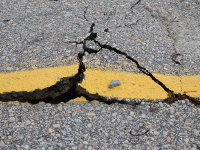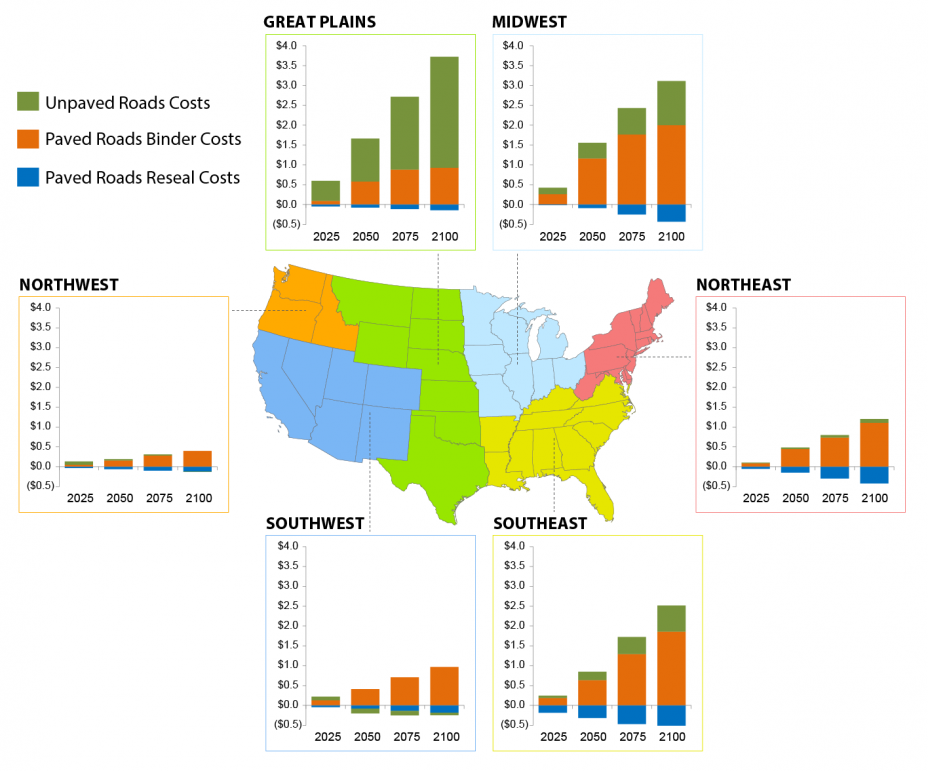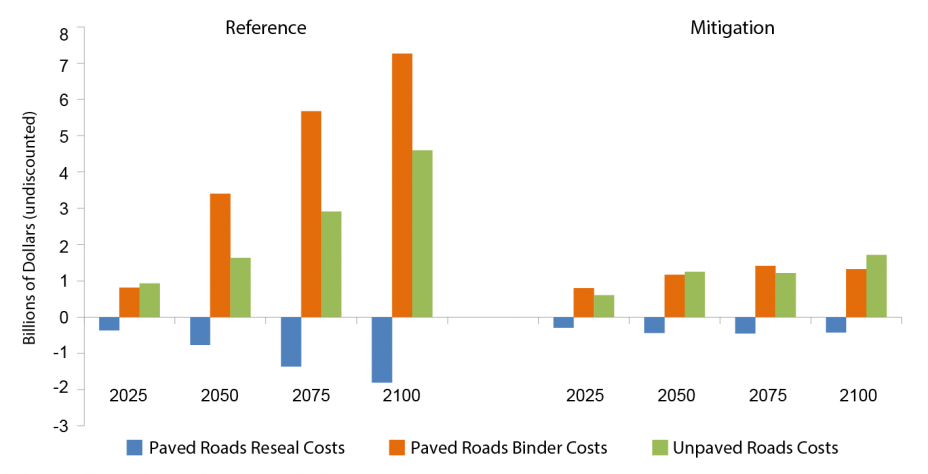Climate Action Benefits: Roads

The U.S. road network is one of the nation’s most important capital assets. Climate stress on roads will likely change in the future, with various potential impacts and adaptation costs.13 For example, roads may experience more frequent buckling due to increased temperatures, more frequent washouts of unpaved surfaces from increases in intense precipitation, and changes in freeze-thaw cycles that cause cracking.14
On this page:
Additional information:
Key Findings
- Climate change is projected to increase the cost of maintaining road infrastructure. This analysis estimates the damages of climate change in terms of increased costs to maintain current levels of service (i.e. adaptation costs). Without adaptation, climate change could render many roadways unusable, leading to large economic damages.
- In all regions, adaptation costs associated with the effects of higher temperatures on paved roadways are estimated to increase over time. In the central regions of the country, in particular, changes in precipitation patterns are projected to increase costs associated with re-grading unpaved roadways.
- Without global GHG mitigation, adaptation costs in 2100 in the U.S. roads sector are estimated to range from $5.8-$10 billion.
- Global GHG mitigation is projected to avoid an estimated $4.2-$7.4 billion of the damages under the Reference scenario in 2100.
Risks of Inaction
Without reductions in global GHG emissions, the costs of maintaining, repairing, and replacing pavement are projected to increase, which is consistent with the findings of the assessment literature regarding adaptation costs for road infrastructure.15 Figure 1 presents the estimated regional damages (in the form of adaptation costs) to the U.S. road network under the Reference scenario using the ISGM-CAM climate model. The greatest impacts are projected to occur in the Great Plains region, where costs are mainly due to erosion of unpaved roads associated with increased precipitation. Costs associated with the use of different pavement binders to avoid cracking of paved roads are also high, particularly in the Midwest and Southeast regions, and they increase over time in all regions due to the projected rise in temperature. Costs of resealing roads after freeze-thaw events decrease over time as the climate changes, but the magnitude of the decrease does not offset the projected increase in other costs.
Figure 1. Projected Impacts of Unmitigated Climate Change on U.S. Road Infrastructure
 Adaptation costs (billions 2014$, undiscounted) under the Reference scenario using the IGSM-CAM climate model. Results are presented for the six regions used in the Third National Climate Assessment.
Adaptation costs (billions 2014$, undiscounted) under the Reference scenario using the IGSM-CAM climate model. Results are presented for the six regions used in the Third National Climate Assessment.
download the figure; download the data
Reducing Impacts through GHG Mitigation
Adaptation costs for the U.S. road network are substantially reduced with global GHG mitigation compared to the Reference scenario (Figure 2). The cost reductions are due in large part to the effect of lower temperatures under the Mitigation scenario on maintenance needs for paved roads. Specifically, costs associated with asphalt binders account for a large share of the adaptation costs nationally under the Reference, and these costs are significantly lower with mitigation. Costs associated with adaptation for unpaved roads are also substantially lower under the Mitigation scenario, as heavy precipitation events are projected to be less severe compared to the Reference. Costs of resealing roads after freeze-thaw cycles are projected to decrease under both scenarios, but the magnitude of the decrease does not offset the projected increase in other costs.
By 2050, the adaptation costs under the Reference scenario are substantially higher, illustrating the benefits that accrue over time with GHG mitigation. In addition, although the costs of adaptation increase over the course of the century under both scenarios, they do so at a much faster rate under the Reference. Under the Reference, adaptation costs are estimated at approximately $10 billion in 2100, whereas under the Mitigation scenario costs are estimated at $2.6 billion. As a result, global GHG mitigation is projected to avoid over $7 billion in damages in 2100. These results rely upon climate projections from the IGSM-CAM, which projects a relatively wetter future for most of the U.S. compared to the MIROC climate model (see the Levels of Certainty section of this report for more information). The projected benefits of global GHG mitigation are lower with the drier MIROC model (not shown), at $4.2 billion in 2100, reflecting the reduced impact of precipitation on unpaved roads under both scenarios.16
Figure 2. Projected Impacts on U.S. Road Infrastructure with and without Global GHG Mitigation
 Costs of adaptation for the Reference and Mitigation scenarios using the IGSM-CAM climate model (billions 2014$). The reduction in adaptation costs under the Mitigation scenario relative to the Reference reflects the benefits of global GHG mitigation.
Costs of adaptation for the Reference and Mitigation scenarios using the IGSM-CAM climate model (billions 2014$). The reduction in adaptation costs under the Mitigation scenario relative to the Reference reflects the benefits of global GHG mitigation.
download the figure; download the data
Approach
The CIRA approach assesses four risks to road infrastructure associated with climate change:
- rutting of paved roads from precipitation;
- rutting of paved roads caused by freeze-thaw cycles;
- cracking of paved roads due to high temperatures; and
- erosion of unpaved roads from precipitation.
The CIRA analysis examines the implications of changes in climate over time for the U.S. road network based on stressor-response functions for each of the above effects. The analysis considers the effects of temperature and precipitation, but does not include impacts due to sea level rise and storm surge, which would likely increase damages to roads. The analysis relies upon climate projections from two climate models: IGSM-CAM, which projects a relatively wetter future for most of the U.S., and the drier MIROC model.
The costs of adaptation to effectively counteract the climate change impacts and maintain roads at their current levels of service are estimated for each of the CIRA scenarios. As there will be continued maintenance needs over time, this analysis focuses on the additional costs due to climate change. The response measures include more frequent resealing to avoid rutting; use of different pavement binders during resurfacing to avoid cracking of asphalt-paved roads; and more frequent re-grading of unpaved roads to minimize erosion impacts. This analysis assumes well-timed adaptation to maintain service levels, a potentially overly optimistic assumption given that infrastructure investments are oftentimes delayed.
For more information on the CIRA approach and results for the roads sector, please refer to Neumann et al. (2014)17 and Chinowsky et al. (2013).18
